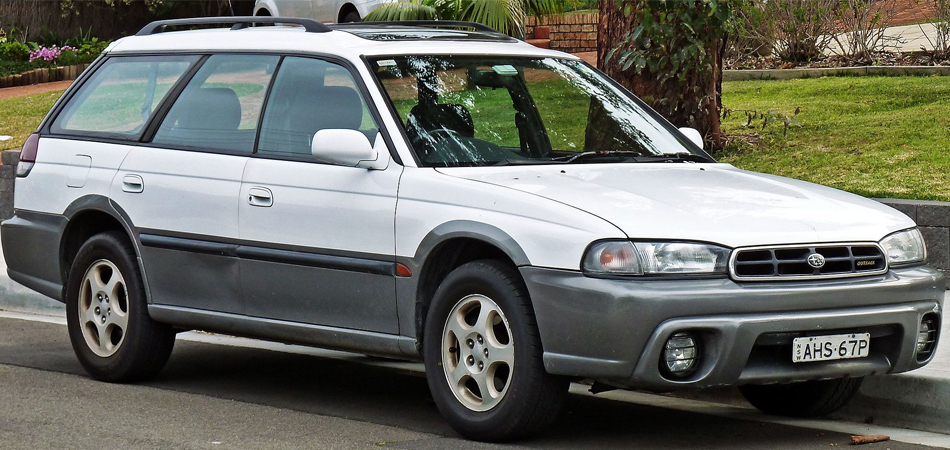The Subaru Outback is well regarded by many who love all the benefits of a large SUV with all-wheel-drive, but enjoy less of a truck feel. Over the years the Outback has changed, growing larger and more luxurious, with no other wagon offering the same level of style, comfort, features, price, and off-road ability. With seating for up to five people, it has offered roomy seats and plenty of cargo space.
First Generation (1995-1999)
First marketed as an Outback wagon, Subaru used the second generation of the Legacy wagon as the basis for the first-generation Outback. The first-generation Outback had two engine options: a 2.2-liter with 135 horsepower and a 2.5-liter with 155 horsepower. A five-speed manual transmission was standard and came with a 50/50 division of power between the front and rear wheels. An optional 4-speed automatic transmission used an electronic system. It featured a two-tone paint job, an upgraded interior from the Legacy and added Outback badges. It upgraded upholstery, added mud flaps, and featured larger wheels and tires.

In 1997, a new Limited trim was introduced, offering leather seats, fancier wheels and more upscale options.
Second Generation (2000-2004)
The second-generation Legacy-based Outbacks were longer, taller, and wider than their predecessors and offered a 3.0-liter six-cylinder boxer engine that produced 212 horsepower as an option. The updated base 2.5-liter four cylinder now makes 165 horsepower and both manual or automatic transmissions were offered. A number of specialty trims arrived, including the L.L. Bean, VDC and Audio. An Impreza-based Outback Sport also became available. The Outback gained more high-end features, like a power driver’s seat, a dual-panel sunroof, and heated seats. Safety features such as stability control and side airbags became available, as well as additional ground clearance.

Third Generation (2005-2009)
Redesigned for 2005, the Outback grew in size for this generation with increased ground clearance and was offered as a sedan or wagon body style from 2005-2007. It updated its looks to a sleeker front end, more aggressive wheels and more luxurious interior. The Outback also received a turbocharged XT trim. It produced 250 horsepower with its 2.5-liter turbocharged engine and was paired with a 5-speed manual or a 5-speed automatic transmission. For 2006, the 2.5-liter four-cylinder models rose to 175 horsepower.

In 2008, the Outback sedan was dropped, as well as the popular L.L. Bean edition. The interior and exterior also got redesigned.
Fourth Generation (2010-2014)
The fourth generation Outback gained 2.8 inches in its wheel-base and expanded its width 3.6 inches, making for a more spacious cabin. It was completely redesigned with new standard features including steering wheel audio controls, electric parking brake with a hill hold function, double-wishbone rear suspension, brake assist, overhead console and auto-on headlights. The turbocharged engine was dropped. It is now available with a 170 horsepower naturally-aspirated 2.5-liter four-cylinder with six-speed manual transmission or optional six-speed CVT. New for 2010 is a 3.6-liter six-cylinder with a five-speed automatic transmission. Limited editions feature leather seating, dual-zone automatic climate control, 440-watt nine-speaker audio system, and Bluetooth hands-free phone capability.

The 2011 Outback receives standard XM satellite radio and folding exterior mirrors on all models. The 2012 Premier and Limited models receive a standard USB port, as well as revised audio equipment.
For 2013, the front fascia has been slightly revised, giving the Outback a smoother nose. It’s standard 2.5-liter engine gets an additional 2 mpg in the city and 1 mpg on the highway along with a revised constantly variable transmission (CVT) and suspension. Extra optional features include remote start, adaptive cruise control and a collision-avoidance system.
The EyeSight driver assistance system is now standard in 2014 on the 2.5i Premium model; and it includes adaptive cruise control, pre-collision braking and vehicle lane departure warning.
2015-2019 (Fifth Generation)
The fifth-generation Subaru Outback is now classified as a ‘crossover’, with the body and wheelbase set larger than previous models. With its new look, it also receives an enhanced all-wheel-drive system, increased cargo and passenger volume, and a smoother and quieter ride.
For 2016, EyeSight driver-assist technology adds lane keep assist and Subaru’s Starlink Safety and Security features come in two packages: Safety Plus, and Safety Plus & Security Plus. Four trim levels are offered: 2.5i, 2.5i Premium, 2.5i Limited, and 3.6R Limited.
Touring trim debuted in 2017 and Subaru added available reverse automatic braking
In 2018, Outback added standard Apple CarPlay and Android Auto; and updated its interior and exterior styling.
2020 – Present (Sixth Generation)
The fully redesigned 2020 Outback adopts a new platform designed to provide a better ride, improved handling and reduce noise levels. It also receives new taillights and an updated, modern interior. Two engines are offered – a standard 2.5-liter four-cylinder with 182 horsepower and an available turbocharged 2.4-liter engine with 260 horsepower. Both engines come with a continuously variable automatic transmission (CVT). Subaru’s suite of active safety features is standard and includes automatic emergency braking, adaptive cruise control and lane-centering steering assist. It comes standard with a Starlink infotainment system with two 7-inch touch screens; and an 11.6-inch touch screen is standard in all models except the base trim. The Outback is available in seven trims: base, Premium, Limited, touring, Onyx Edition XT, Limited XT, and Touring XT. The XT trims come with the stronger 260-horsepower turbocharged engine.
The Outback gets an estimated 26/33 mpg in the city and on the highway with the base engine and 23/30 mpg city/highway for the upgraded turbocharged engine.
For 2021, rear seat reminder and steering-responsive headlights are now standard. Otherwise, 2020 and 2021 models are mostly identical. Pricing starts at $26,795.